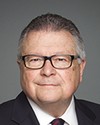Sure.
Mr. Chairman, members of the committee, thank you very much for the opportunity.
My objection, of course, has been circulated in writing, so I won't take your time to read through all of it.
I support the report and the map proposed by the majority of the boundaries commission in Saskatchewan, that is Queen's Bench judge, Mr. Justice Ronald Mills, who comes from a rural community near Prince Albert, and professor emeritus, Dr. John Courtney, from Saskatoon, who is acknowledged to rank with the leading three or four political scientists in this country.
Saskatchewan is very proud of both of them. Through long years of experience and service, they are steeped in the heritage and the values that characterize Saskatchewan. That, along with their reputations for intelligence and hard work, are probably the reasons why they were selected by the Chief Justice and by the Speaker to serve on the independent, arm's-length, non-partisan, quasi-judicial boundaries commission for Saskatchewan.
I stress all of this about their backgrounds and their values because both have been under a bit of attack by robocalls, and push polls, and the like. There has been a concerted campaign to discredit their work, and this committee needs to know that Judge Mills and Dr. Courtney are two individuals of very high standing.
There was a dissenting opinion in the commission's report for Saskatchewan, filed by the third member, David Marit. It is that dissent with which I respectfully disagree. What's at issue here is the strategic approach underlying redistribution in Saskatchewan. Mr. Marit argues for the status quo with minimal adjustments because he supports exclusively rural or mixed rural-urban ridings with no clear urban voices.
The majority of the commission took a different view, consistent with much of the reasoned evidence before them. They noted that Saskatchewan's population is growing and it is becoming increasingly urbanized. More than 75% of the province's people live in urban centres of all sizes; 40% live in Regina and Saskatoon alone. Yet not one single Saskatchewan riding is distinctively urban at the present time. Not one. All 14 are either purely rural or mixed.
To address that, the commission majority produced a measured, reasoned, and balanced plan. They have not gone whole hog in the other direction. They have proposed a variety of ridings that accurately represent the vast diversity that is Saskatchewan's reality. Instead of having a map that is artificially stacked 14 to nothing against any distinctive urban representation whatsoever, the majority proposed a realistic blend of six predominantly rural ridings, one more than exists today, five urban ridings—three in Saskatoon and two in Regina, instead of none today—and three largely mixed ridings. It is I think a fair balance. This configuration will allow both rural and urban voices to be reflected in the House of Commons without one swamping the other, without communities of common interest being compromised or obscured.
In other provinces, I note that other MPs from other parties, including the government, have underlined the importance of this same principle. I think of Mr. Calkins from Wetaskiwin as one example.
The key point here is reflected actually in the structure of Saskatchewan's municipal organizations. There are two of them, not just one. One is distinctively rural and the other is urban. Why? Because the interests they represent are different and each deserves focused, full-time attention. They are both important. They need to work well together. But each has a distinctive voice that must be heard in its own right. It's fundamental to fairness in our democracy. That's why I disagree with the dissent and I strongly support the majority report of the Saskatchewan commission.
Thank you, Mr. Chair.

